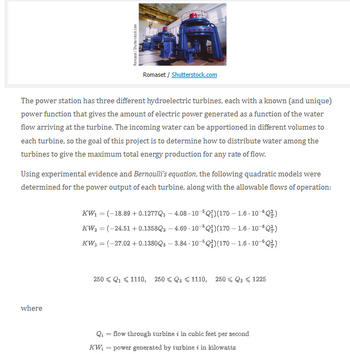
Mathematics For Machine Technology
8th Edition
ISBN: 9781337798310
Author: Peterson, John.
Publisher: Cengage Learning,
expand_more
expand_more
format_list_bulleted
Question

Transcribed Image Text:KW; = power generated by turbinė 2 in kilowatts
QT = total flow through the station in cubic feet per second
1. If all three turbines are being used, we wish to determine the flow Q, to each turbine that will
give the maximum total energy production. Our limitations are that the flows must sum to the
total incoming flow and the given domain restrictions must be observed. Consequently, use
Lagrange multipliers to find the values for the individual flows (as functions of Qr) that
maximize the total energy production
KW₁+KW₂+KW3
subject to the constraints
Q1 + Q2 +Qs = QT
and the domain restrictions on each Q..
2. For which values of QT is your result valid?
3. For an incoming flow of 2500 ft³/s, determine the distribution to the turbines and verify (by
trying some nearby distributions) that your result is indeed a maximum.
4. Until now we have assumed that all three turbines are operating; is it possible in some
situations that more power could be produced by using only one turbine? Make a graph of the
three power functions and use it to help decide if an incoming flow of 1000 ft³/s should be
distributed to all three turbines or routed to just one. (If you determine that only one turbine
should be used, which one would it be?) What if the flow is only 600 ft³/s?
5. Perhaps for some flow levels it would be advantageous to use two turbines. If the incoming
flow is 1500 ft³/s, which two turbines would you recommend using? Use Lagrange multipliers
to determine how the flow should be distributed between the two turbines to maximize the
energy produced. For this flow, is using two turbines more efficient than using all three?
6. If the incoming flow is 3400 ft³/s, what distribution would you recommend to the station
management?

Transcribed Image Text:Rama/Shutterstock.com
Romaset/Shutterstock.com
The power station has three different hydroelectric turbines, each with a known (and unique)
power function that gives the amount of electric power generated as a function of the water
flow arriving at the turbine. The incoming water can be apportioned in different volumes to
each turbine, so the goal of this project is to determine how to distribute water among the
turbines to give the maximum total energy production for any rate of flow.
Using experimental evidence and Bernoulli's equation, the following quadratic models were
determined for the power output of each turbine, along with the allowable flows of operation:
6
KW₁ = (-18.89 +0.1277Q1-4.08.10 Q) (170 - 1.6 · 10¯*Q)
KW2 = (-24.51 +0.1358Q2-4.69-10 Q¹²) (170 — 1.6 · 10¯*Q)
KW3 = (-27.02 +0.1380Q3 -3.84-10-5Q) (170 - 1.6-10-ºQ)
where
250 Q1 <1110, 250 Q2 <1110, 250 <3 < 1225
Qi = flow through turbine i in cubic feet per second
KW
=
power generated by turbine i in kilowatts
Expert Solution
This question has been solved!
Explore an expertly crafted, step-by-step solution for a thorough understanding of key concepts.
Step by stepSolved in 2 steps

Knowledge Booster
Similar questions
- What is a carrying capacity? What kind of model has a carrying capacity built into its formula? Why does this make sense?arrow_forwardSuppose one canoe rents for 40,and2 is taken off the price for each additional canoe rented by a ground. What size group gives the most income? Assume that there are 20 canoes available.arrow_forward
Recommended textbooks for you
 Mathematics For Machine TechnologyAdvanced MathISBN:9781337798310Author:Peterson, John.Publisher:Cengage Learning,Algebra & Trigonometry with Analytic GeometryAlgebraISBN:9781133382119Author:SwokowskiPublisher:Cengage
Mathematics For Machine TechnologyAdvanced MathISBN:9781337798310Author:Peterson, John.Publisher:Cengage Learning,Algebra & Trigonometry with Analytic GeometryAlgebraISBN:9781133382119Author:SwokowskiPublisher:Cengage
 Functions and Change: A Modeling Approach to Coll...AlgebraISBN:9781337111348Author:Bruce Crauder, Benny Evans, Alan NoellPublisher:Cengage Learning
Functions and Change: A Modeling Approach to Coll...AlgebraISBN:9781337111348Author:Bruce Crauder, Benny Evans, Alan NoellPublisher:Cengage Learning

Mathematics For Machine Technology
Advanced Math
ISBN:9781337798310
Author:Peterson, John.
Publisher:Cengage Learning,

Algebra & Trigonometry with Analytic Geometry
Algebra
ISBN:9781133382119
Author:Swokowski
Publisher:Cengage


Functions and Change: A Modeling Approach to Coll...
Algebra
ISBN:9781337111348
Author:Bruce Crauder, Benny Evans, Alan Noell
Publisher:Cengage Learning